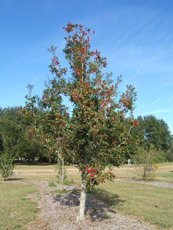Ilex x attenuata 'Savannah' (Savannah Holly)

*Click on picture for more images of this species.
- USDA Hardiness Zone: 6A - 9B
- Mature Height: 30 to 45 ft
- Mature Spread: 6 to 10 ft
- Growth Rate: Moderate
- Availability: Generally available
- Drought Tolerance: High
- Salt Tolerance: Moderate
- Light Requirements: Full sun to partial sun
- Native Origin: Native to North America
- Soil Drainage: Needs a well-drained site.
- Foliage: Evergreen tree with no showy fall color.
- Flowers: White, not showy flowers in the spring.
- Pests: Savannah Holly is usually pest-free but it can be affected by leaf miners, scale, spider mites, tar spot and leaf spots.
Description: Savannah Holly is a beautifully shaped tree, with a narrow, open pyramidal to columnar form. A 35-foot-tall tree can be eight feet wide in 40 years, indicating a moderate growth rate. The spiny, dull, dark green leaves have wavy margins and are accented in fall with heavy clusters of red berries which persist throughout the fall and winter. Male and female flowers appear on separate trees and must be located in the same neighborhood to ensure production of berries. Many nurserymen propagate from female trees so most nursery trees have berries. Many trees are grown with a central trunk and skinny lateral branches, although some nurseries offer those with several upright trunks growing straight up through the crown. Many trees are sheared in the nursery to create more branches and a fuller canopy than will be seen several years after planting.
Savannah Holly is ideal for use as a street tree, framing tree, specimen, or barrier planting. There are better screens available such as Nellie R Stevens Holly and Foster's Holly, which are denser than the open-canopied Savannah Holly. Roots are rarely invasive due to their great number and relatively small diameter. This native tree is ideal for naturalizing on moist, slightly acid soils, and the fruit is very attractive to wildlife, serving as an excellent food source. A popular landscape plant, this broad-leafed evergreen has served a variety of uses through the years.
The American Indians used preserved Savannah Holly berries as decorative buttons and were much sought after by other tribes who bartered for them. The wood has been used for making canes, scroll work and furniture, and has even been substituted for ebony in inlay work when stained black. Growing well in full sun to partial shade, Savannah Holly should be located on fertile, well-drained but moist, slightly acid soils. Berry production is best in full sun. Savannah Holly foliage thins slightly during drought but insect and disease infestations are usually minimal.
Gainesville Observations: Trees grow slowly but appear well adapted to this region of Florida. Foliage remains yellow-green unless fertilized. Berry production has been good. Ten year old trees in a lightly fertilized plot are about 12 feet tall.
Fact Sheet (pdf)
Click here for more photos of this tree.

